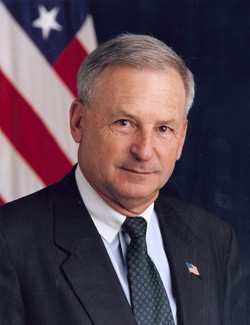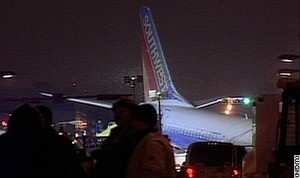Asks Carriers To Not Factor Reverse Thrust In Computing Landing
Distance
 As the one-year
anniversary of a tragic runway overrun accident approaches,
National Transportation Safety Board Chairman Mark V. Rosenker
(right) is urging airlines to voluntarily adopt changes in the
way they calculate stopping distances on contaminated runways, in
accordance with Federal Aviation Administration (FAA) guidance
issued in response to an urgent NTSB recommendation.
As the one-year
anniversary of a tragic runway overrun accident approaches,
National Transportation Safety Board Chairman Mark V. Rosenker
(right) is urging airlines to voluntarily adopt changes in the
way they calculate stopping distances on contaminated runways, in
accordance with Federal Aviation Administration (FAA) guidance
issued in response to an urgent NTSB recommendation.
As Aero-News reported, on
December 8, 2005, Southwest Airlines flight 1248, a Boeing 737-7H4,
landed on runway 31C at Chicago Midway Airport during a snow storm.
The aircraft failed to stop on the runway, rolling through a blast
fence and perimeter fence and coming to rest on a roadway after
striking two vehicles. A six-year-old boy in one of the automobiles
was killed.
While approaching Chicago on a flight from Baltimore, the pilots
used an on-board laptop performance computer (OPC) to calculate
expected landing performance. Information entered into the computer
included expected landing runway, wind speed and direction,
airplane gross weight at touchdown, and reported runway braking
action. The OPC then calculated the stopping margin. Depending on
whether WET- FAIR or WET-POOR conditions were input, the computer
calculated remaining runway after stopping at either 560 feet or 30
feet.
These calculations were based on the assumption that the engine
thrust reversers would be deployed immediately upon touchdown.
However, flight data recorder information revealed that the thrust
reversers were not deployed until 18 seconds after touchdown, at
which point there was only about 1,000 feet of usable runway
remaining.
As a result of the accident, on January 27, 2006, the Safety
Board urged the Federal Aviation Administration to prohibit airlines from using credit for
the use of thrust reversers when calculating stopping distances on
contaminated runways.
The FAA does not allow operators to take credit for the assumed
deployment of thrust reversers upon landing when performing the
dispatch landing distance calculations. However, once airborne, the
FAA permits operators of certain transport category airplanes like
the 737-700 to assume that deployment of thrust reversers will
occur immediately upon touchdown and take credit for the reduction
in landing distance when pilots re-calculate landing distance just
prior to landing.
 If the thrust reverser
credit had not been allowed in calculating the stopping distance
for flight 1248, the OPC would have indicated that a safe landing
on runway 31C was not possible.
If the thrust reverser
credit had not been allowed in calculating the stopping distance
for flight 1248, the OPC would have indicated that a safe landing
on runway 31C was not possible.
The FAA responded to the recommendation by publishing a notice
in June 2006 that it would issue a mandatory Operations
Specification (OpSpec) concerning landing distance calculations
that would be effective September 1, 2006. Although the OpSpec did
not address reverse thrust credit, it addressed many issues in
calculating landing distance including incorporation of a 15%
safety factor.
The FAA subsequently announced that it believes it needs to
propose this change through the rulemaking process, which will
delay implementation of this change. On August 31, 2006, the FAA
issued a Safety Alert for Operators
(SAFO) urgently recommending that operators of
turbojet airplanes voluntarily comply with the OpSpec
immediately.
"We think airlines should voluntarily adopt the procedures
contained in the FAA's OpSpec now, as we are entering another
winter flying season," Chairman Rosenker said.
Chairman Rosenker noted that Midway Airport has improved the
safety margin at its runways in the past year, by installing the Engineered Materials
Arresting System (EMAS). EMAS uses materials placed at
the end of a runway to stop or slow an aircraft that overruns the
runway.
 Bolen Gives Congress a Rare Thumbs-Up
Bolen Gives Congress a Rare Thumbs-Up The SportPlane Resource Guide RETURNS!!!!
The SportPlane Resource Guide RETURNS!!!! Buying Sprees Continue: Textron eAviation Takes On Amazilia Aerospace
Buying Sprees Continue: Textron eAviation Takes On Amazilia Aerospace Hawker 4000 Bizjets Gain Nav System, Data Link STC
Hawker 4000 Bizjets Gain Nav System, Data Link STC Echodyne Gets BVLOS Waiver for AiRanger Aircraft
Echodyne Gets BVLOS Waiver for AiRanger Aircraft




